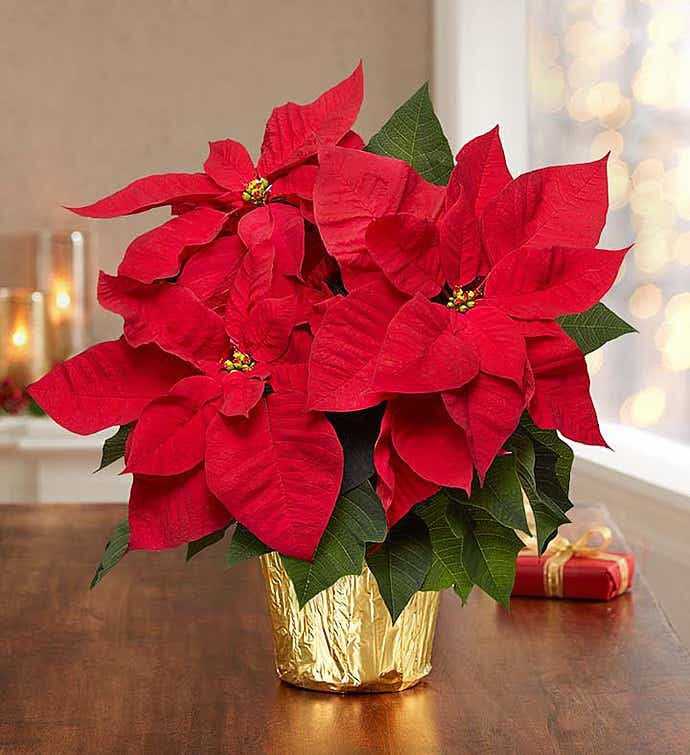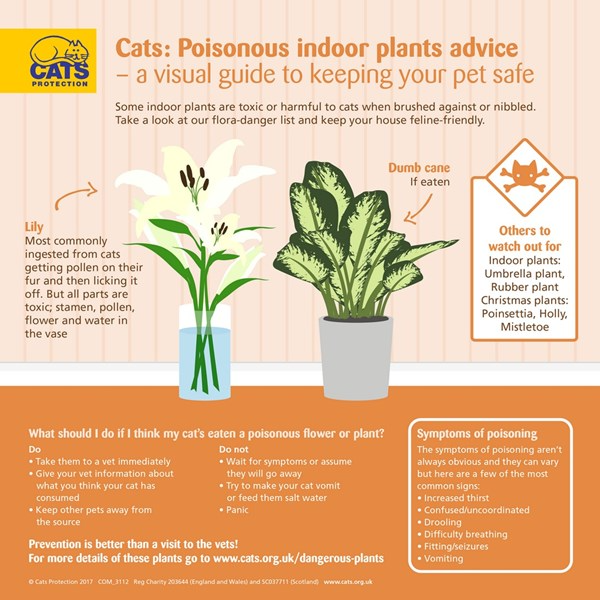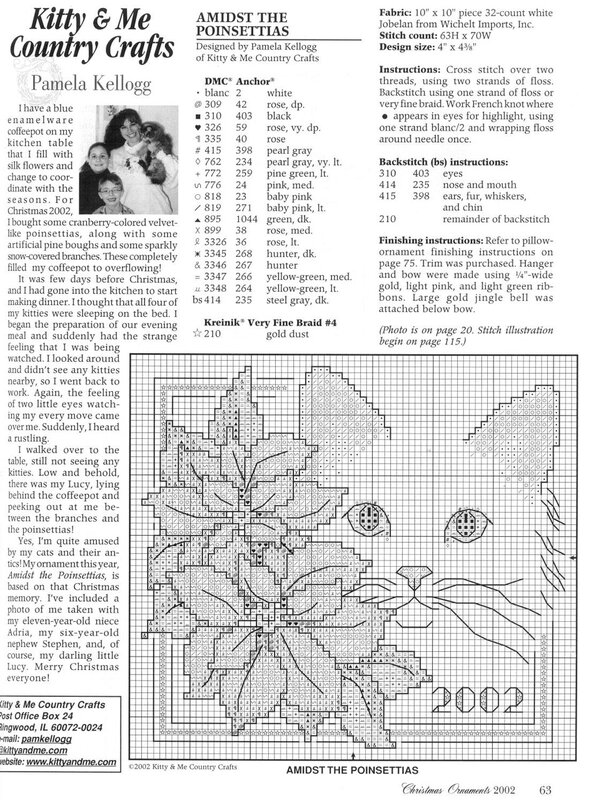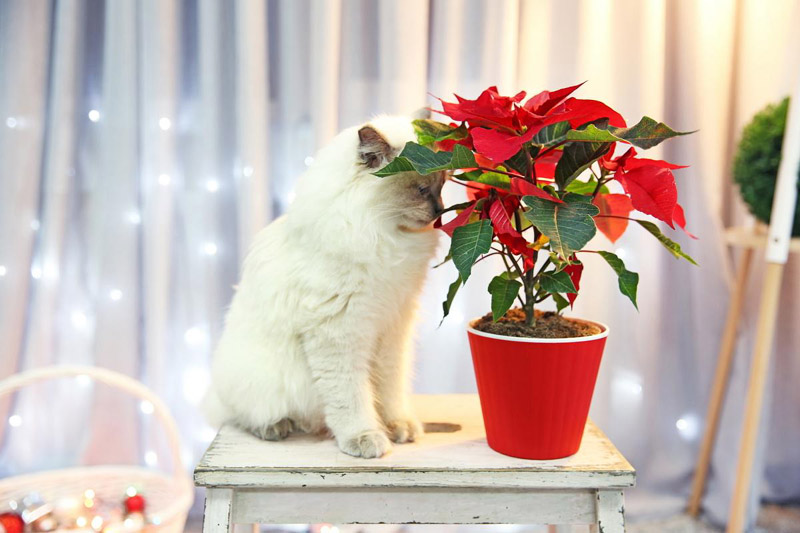Poinsettia dangerous for cats
Pretty Poinsettias are Bad for Cats!
If you are a cat owner, then you should be careful this holiday season with what plants you bring into your home. Poinsettias, lilies, holly berries and mistletoe are all problematic to your feline family members.
Of all of these festive plants, lilies are the most toxic and are potentially fatal if ingested by cats. Any part of the plant, including the pollen, flower, stems and leaves are poisonous. These plants belong to the Lilium or Hemerocallis family, with examples being the tiger, day, Asiatic hybrid, Easter, Japanese Show, rubrum, stargazer, red, Western, and wood lilies. If ingested, these lilies can cause kidney failure in cats, with sudden onset of lethargy, decreased appetite, vomiting and either increased or decreased thirst and urination with dehydration. If you suspect your cat has eaten any part of a lily plant then take him directly to your veterinarian as emergency care is needed. The best advice is not to bring any lilies into your home if you have cats, and be sure to inspect any bouquets of flowers that are delivered to your home, as lilies are the #1 flower used by florists!
Poinsettias are not very toxic to cats, but the milky white sap found in poinsettias contains chemicals called diterpenoid euphorbol esters and saponin-like detergents. If ingested, these substances will cause digestive upset, such as vomiting, drooling, or rarely, diarrhea may be seen. If the milky sap is exposed to skin, dermal irritation (including redness, swelling, and itchiness) may develop. Rarely, eye exposure can result in mild conjunctivitis (“pink eye” secondary to inflammation). Signs are self-limiting and don’t require medical treatment unless severe.
Other yuletide plants such as holly berries and mistletoe can also be toxic to cats. When Christmas or English holly is ingested, it can result in severe gastrointestinal upset thanks to the spiny leaves and the potentially toxic substances (including saponins, methylxanthines, and cyanogens). If ingested, most cats lip smack, drool, and head shake excessively due to the mechanical injury from the spiny leaves. As for mistletoe, most of us hang it high enough, so it’s out of reach of our cats – nevertheless, it can also be toxic if ingested. Thankfully, American mistletoe is less poisonous than the European varieties of it. Mild signs of gastrointestinal irritation are seen, although if ingested in large amounts, collapse, hypotension, ataxia (walking drunk), seizures and death have also been reported. If you suspect your cat has ingested either of these plants, he should be seen by your veterinarian.
Mild signs of gastrointestinal irritation are seen, although if ingested in large amounts, collapse, hypotension, ataxia (walking drunk), seizures and death have also been reported. If you suspect your cat has ingested either of these plants, he should be seen by your veterinarian.
If you want more information on toxic plants for cats, you can visit the American Society for Prevention of Cruelty to Animals (ASPCA) Poison Control website at https://www.aspca.org/pet-care/animal-poison-control
Have a safe and happy holiday season!
Written by Tiffany Lennox, DVM
Share this post:
Back to the Blog
Poinsettia Are Toxic To Pets
Poinsettia Are Toxic To Pets | Pet Poison HelplineExact matches only
Exact matches only
Search in title
Search in title
Search in content
Search in content
Search in excerpt
Hidden
Hidden
Hidden
Hidden
plants
Alternate names
Euphorbia, lobster flower, flame leaf flower, Flower of the Holy Night, Flower of Christmas Eve, Crown of the Andes, Easter flower
During the holidays, poinsettias are a popular Christmas plant. Though they have a bad rap, poinsettia (Euphorbia pulcherrima) plants are only mildly toxic to cats and dogs. The milky white sap found in poinsettias contains chemicals called diterpenoid euphorbol esters and saponin-like detergents. While poinsettias are commonly “hyped” as poisonous plants, they rarely are, and the poisoning is greatly exaggerated. When ingested, mild signs of vomiting, drooling, or rarely, diarrhea may be seen. If the milky sap is exposed to skin, dermal irritation (including redness, swelling, and itchiness) may develop. Rarely, eye exposure can result in mild irritation. Signs are generally self-limiting and typically don’t require medical treatment unless severe and persistent. There is no antidote for poinsettia poisoning. That said, due to the low level of toxicity seen with poinsettia ingestion, medical treatment is rarely necessary unless clinical signs are severe.
Though they have a bad rap, poinsettia (Euphorbia pulcherrima) plants are only mildly toxic to cats and dogs. The milky white sap found in poinsettias contains chemicals called diterpenoid euphorbol esters and saponin-like detergents. While poinsettias are commonly “hyped” as poisonous plants, they rarely are, and the poisoning is greatly exaggerated. When ingested, mild signs of vomiting, drooling, or rarely, diarrhea may be seen. If the milky sap is exposed to skin, dermal irritation (including redness, swelling, and itchiness) may develop. Rarely, eye exposure can result in mild irritation. Signs are generally self-limiting and typically don’t require medical treatment unless severe and persistent. There is no antidote for poinsettia poisoning. That said, due to the low level of toxicity seen with poinsettia ingestion, medical treatment is rarely necessary unless clinical signs are severe.
Common signs to watch for:
- Drooling
- Licking lips
- Vomiting
- Diarrhea
- Skin irritation (including redness, swelling, and itchiness)
- Eye irritation
Speak to an expert now:
(855) 764-7661
75 incident fee applies
Call now:
(855) 764-7661
- Dogs
- Cats
- dogDogs
- catCats
Dogs
Toxicity Level
Mild
Cats
Toxicity Level
Mild
Disclaimer
The content of this page is not veterinary advice. A number of factors (amount of substance ingested, size of the animal, allergies, etc.) determine what is toxic to a particular pet. If you think your pet has eaten something potentially toxic, call Pet Poison Helpline or seek immediate veterinary treatment.
A number of factors (amount of substance ingested, size of the animal, allergies, etc.) determine what is toxic to a particular pet. If you think your pet has eaten something potentially toxic, call Pet Poison Helpline or seek immediate veterinary treatment.
This website uses cookies. We use cookies for our legitimate interests of providing you with personalized content, enabling you to more easily use our website, evaluating use of our website, and assisting with ad reporting functions. For more detailed information about how we use cookies, please review our Privacy Policy. By checking the "I agree" box, you consent to our use of cookies on this website. You may revoke this consent by contacting SafetyCall at [email protected] or call 952-806-3812 or you may choose to manage cookies in your browser settings. Certain cookies are necessary for the website to function. If you do not agree to this consent or disable certain cookies in your browser settings, you’ll be unable to use the website. I agree to Pet Poison Helpline's use of cookies on this website.
I agree to Pet Poison Helpline's use of cookies on this website.
Plants poisonous to cats, dangerous indoor flowers
Plants poisonous to cats, dangerous indoor flowers Phone
or email
Password
- Registration
- Recover password
- Help
Connect autoorder and get up to 30% discount
We create comfort in the house in many ways. Including we decorate window sills and shelves with a variety of house plants. Some attract with their bright flowering, while others simply delight the eye with rich green leaves. But in a house where there are cats, every green leaf can be potentially dangerous. There are houseplants that are toxic to cats. Some of them are so popular that they are in almost every home, and the owners believe that pets are smart enough to understand which of the leaves should not be chewed. Unfortunately, it is not. In this article, we will provide a list of houseplants that are dangerous for cats. Familiarize yourself with it and look around: is there a poisonous decoration on your windowsill?
Unfortunately, it is not. In this article, we will provide a list of houseplants that are dangerous for cats. Familiarize yourself with it and look around: is there a poisonous decoration on your windowsill?
Why do cats eat plants?
The reasons may be different. Sometimes the behavior of pets is driven by banal interest. Also, eating grass and plants may be associated with a lack of certain vitamins, the cat will want to empirically find their source. But most often, chewing greens is not a whim, but a physical necessity: in this way, the animal removes wool from the stomach or tries to quench its thirst if there is no access to drinking water.
Which houseplants are dangerous for cats?
There is a very long list of plants that are toxic to your pets. The degree of their danger is also different: some cause only vomiting and diarrhea, others burn the mucous membrane with their juice and cause inflammation, and some depress the central nervous system, can lead to convulsions and even death. If you have plants from the following list in your home, limit your cat's access to them.
If you have plants from the following list in your home, limit your cat's access to them.
| Azalea. Beautiful flower with oval emerald leaves and large pink buds. Alas, the beauty of this plant is directly proportional to its danger. Azaleas contain a poisonous alkaloid - andromedotoxin glycoside. This substance depresses the central nervous system and the work of the heart, causes convulsions, swelling of the larynx and kidney failure. |
|
| Begonia. A small flower with carved large leaves and small red, yellow or orange petals. This flower contains a critically large amount of oxalic acid, which irritates and burns the mucous membranes. By swallowing part of this plant, the cat runs the risk of swelling of the larynx. |
|
| Dieffenbachia. An evergreen plant with large oval leaves, pointed at the tip, which are rich green at the edges, fading to lighter shades towards the center. |
|
| Dracaena. A plant on a dense woody stem with a "shock" of long narrow leaves. The leaves of this plant attract cats, but for a pet, this is fraught with swelling of the larynx, vomiting and difficulty breathing. |
|
| Peperomia. The poisonous substances contained in the round dark green leaves of this plant can cause swelling of the larynx and incoordination, and even acute heart failure. |
|
| Ficus, spurge, poinsettia. For cats (and even for humans), flowers from the genus Euphorbia are dangerous. |
|
| Philodendron. The large emerald leaves of this evergreen plant contain many toxic substances in their juice, including caustic acid. Contact with the juice on the mucous membrane causes severe inflammation and burns. |
|
| Cyclamen. Indoor flower with heart-shaped leaves and delicate petals of various colors (pink, white, red, purple, etc.). The juice of this plant contains alkaloids that cause cardiac and respiratory arrest. |
|
This list does not include absolutely all indoor plants dangerous to cats. You should find out the names of all the flowers growing in the apartment and find out how dangerous they are for your pets.
How to protect a cat from houseplant poisoning?
The most radical and reliable way is to leave in the apartment only those flowers that will definitely not harm the cat. If you are not ready to part with your favorite plants, place them in the apartment in such a way that pets cannot reach them, for example, place them in hanging planters on the wall. You can also use special sprays that, with the help of smell, will reduce the cat's interest in the flower. If the cat feels a physical need to eat greens, give her the opportunity to do so. Plant seeds of cat-friendly grass or buy ready-made sprouted bushes. Having access to the coveted green leaves, your pet will agree to leave the houseplants alone. On the page with this article, you can find products that will help you wean your pet from the bad habit of chewing and eating homemade flowers.
- #cats
Other articles
-
Choosing the right harness for your cat is the key to your peace of mind and his comfort on walks or while moving.
 Read in our article what harnesses are, how to teach a cat to walk on a harness and when you can’t use it.
Read in our article what harnesses are, how to teach a cat to walk on a harness and when you can’t use it.
Read more
Category: Nutrition
How to choose a safe and useful dog toy in all the variety of pet stores? Read on our website how to choose the right toy and 5 rules for playing with a dog.
Read more
Category: Nutrition
Are lovebirds really supposed to live exclusively as a couple? What happens if you buy one lovebird? How to properly maintain and care for these birds, read our article!
Read more
Category: Nutrition
-
buy
Grass for cats (oats for sprouting)
40 g 88 and bonus
1 -
buy
Grass "7 herbs" for cats (tray), sprouting kit
From 55 i
-
buy
Grass "7 herbs" universal (package), seeds for sprouting
100 g 59 and bonus
150 g 39 i
-
buy
Grass for cats (wheat)
From 62 i
-
buy
Repellent spray based on essential oils, 250 ml
From 620 i
-
buy
Repellent spray for cats "Stop it Cat"
149 g 1 236 and bonus
12 -
buy
Automatic spray repeller SSSCat
530 g 10 540 i bonus
105
Your choice:
Total: 0 and
+ set aside
Is the beautiful poinsettia poisonous and can it poison you and your cat?
Useful information
Admin, 23 November 2018 - 17:00
Poinsettia, also known as the Star of Bethlehem, is without a doubt a flower loved by many. It has entered the "canon" of obligatory holiday decorations, almost like a traditional New Year and Christmas tree. Although the plant beautifully decorates our homes, many fear that the poinsettia is a poisonous plant and can cause allergies.
It has entered the "canon" of obligatory holiday decorations, almost like a traditional New Year and Christmas tree. Although the plant beautifully decorates our homes, many fear that the poinsettia is a poisonous plant and can cause allergies.
A lot of negative opinions have accumulated around her, which, however, do not always correspond to reality. Find out if the poinsettia is poisonous or not, in whom it can cause allergies, and what threatens contact with the juice flowing from the shoots of the flower.
Poinsettia - Christmas star - poisonous to humans or not?
The tissues of the poinsettia contain a poisonous white milky juice, just like all other members of the family. This juice contains euphorbic acid, euphorbin and cyanogenic compounds, which can painfully burn the skin, cause inflammation, and if it gets into the eyes, even temporarily blind a person.
Poisonous juices are found in the root, leaves and stems. It is also worth knowing that the bracts that delight us (those that turn so beautifully red) owe their color to dyes belonging to anthocyanins.
All this sounds menacing. And so much so that some believe that the name of the plant comes from the English. the word poison, meaning "poison". But this is just complete nonsense! The name "poinsettia" comes from the surname Poinsett of a man named Joel Roberts who brought the Star of Bethlehem from Mexico to the United States.
In practice, as it turns out, information about the strong toxic effect and poisonousness of poinsettia is greatly exaggerated. Although the Star of Bethlehem can cause gastrointestinal distress, nausea, and vomiting after ingestion, in practice, this accounts for less than 10% of human consumption of the plant. The ailment is usually very mild and rare.
However, if a poinsettia flower has appeared in the house, it should be installed in a place inaccessible to small children, and while caring for the plant, avoid direct contact with juices that can leak out, for example, when breaking a branch. But there is no need to exaggerate. The sheer number of indoor plants grown in our apartments can be far more poisonous than the Star of Bethlehem.
Can poinsettias cause allergies?
Growing poinsettias should be avoided by people who are allergic to latex. Almost every second person with this type of it has symptoms of sensitization upon direct contact with the Star. The result of such contact can be inflammation of the skin, mucous membranes, and much less often - an attack of allergic asthma.
In this regard, the damaged parts of the plant, from which the juice flows, should be handled with care, try not to get dirty, and even more so - do not rub the eye with milk. Wash your hands thoroughly after work, just in case.
Will the Christmas star be poison to your cat or dog?
Poinsettia is not very toxic to pets. So, for example, in the case of cats, the risk can generally be defined as small. Plants such as azalea, oleander, clivia, Persian cyclamen or the very popular ficus benjamin are much more dangerous for a cat.
Advertising
However, it is worth knowing that if the juices of the Christmas star get on the mucous membranes of the animal, they can cause severe irritation and pain.
 The plant is dangerous, even if the cat does not swallow, but chews the leaf. The juice is extremely toxic and causes irritation of the oral mucosa, swelling of the larynx is possible up to respiratory arrest. Once in the eyes, the poison irritates the delicate skin of the eyelids and conjunctiva.
The plant is dangerous, even if the cat does not swallow, but chews the leaf. The juice is extremely toxic and causes irritation of the oral mucosa, swelling of the larynx is possible up to respiratory arrest. Once in the eyes, the poison irritates the delicate skin of the eyelids and conjunctiva.  Their milky juice causes deep non-healing burns, blindness, an allergic reaction, diarrhea, affects the nervous system, leads to inflammation and ulcers.
Their milky juice causes deep non-healing burns, blindness, an allergic reaction, diarrhea, affects the nervous system, leads to inflammation and ulcers. 









